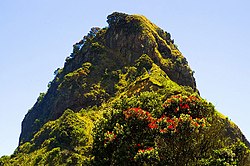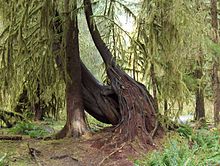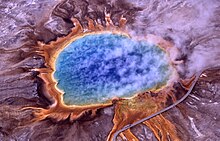This is an old revision of this page, as edited by Prof de loof (talk | contribs) at 08:02, 23 May 2009 (→Proposed). The present address (URL) is a permanent link to this revision, which may differ significantly from the current revision.
Revision as of 08:02, 23 May 2009 by Prof de loof (talk | contribs) (→Proposed)(diff) ← Previous revision | Latest revision (diff) | Newer revision → (diff) For different meanings of related words, see Alive, Live, Live!, Lives, Living For other uses, see Life (disambiguation).
| Life (Biota) | |
|---|---|

| |
| Life on a rocky peak in the Waitakere Ranges | |
| Scientific classification | |
| Domains and Kingdoms | |
Life (cf. biota) is a characteristic of organisms that exhibit biological processes. A diverse array of living organisms (life forms) can be found in the biosphere on Earth. Properties common to these organisms—plants, animals, fungi, protists, archaea, and bacteria — are a carbon- and water-based cellular form with complex organization and heritable genetic information. They undergo metabolism, possess a capacity to grow, respond to stimuli, reproduce and, through natural selection, adapt to their environment in successive generations. More complex living organisms can communicate through various means.
A physical characteristic of life is that it functions on negative entropy. In more detail, according to physicists such as John Bernal, Erwin Schrödinger, Eugene Wigner, and John Avery, life is a member of the class of phenomena which are open or continuous systems able to decrease their internal entropy at the expense of substances or free energy taken in from the environment and subsequently rejected in a degraded form (see: entropy and life). So far, there is no evidence of extraterrestrial life.
Definitions
There is no universal definition of life. To define life in unequivocal terms is still a challenge for scientists, as the definition must be sufficiently broad that would encompass all life with which we are familiar. It should be sufficiently general that, with it, scientists would not miss life that may be fundamentally different from earthly life. In addition, defining life requires measurable terms, and when derived from analysis of known organisms, life is usually defined at cellular level.
Conventional
The consensus is that life is a characteristic of organisms that exhibit all or most of the following phenomena:
- Homeostasis: Regulation of the internal environment to maintain a constant state; for example, electrolyte concentration or sweating to reduce temperature.
- Organization: Being structurally composed of one or more cells, which are the basic units of life.
- Metabolism: Transformation of energy by converting chemicals and energy into cellular components (anabolism) and decomposing organic matter (catabolism). Living things require energy to maintain internal organization (homeostasis) and to produce the other phenomena associated with life.
- Growth: Maintenance of a higher rate of anabolism than catabolism. A growing organism increases in size in all of its parts, rather than simply accumulating matter.
- Adaptation: The ability to change over a period of time in response to the environment. This ability is fundamental to the process of evolution and is determined by the organism's heredity as well as the composition of metabolized substances, and external factors present.
- Response to stimuli: A response can take many forms, from the contraction of a unicellular organism to external chemicals, to complex reactions involving all the senses of higher animals. A response is often expressed by motion, for example, the leaves of a plant turning toward the sun (phototropism) and by chemotaxis.
- Reproduction: The ability to produce new individual organisms either asexually, from a single parent organism, or sexually, from at least two parent organisms.



Proposed
To reflect the minimum phenomena required, some have proposed other definitions of life:
- Living things are systems that tend to respond to changes in their environment, and inside themselves, in such a way as to promote their own continuation.
- A network of inferior negative feedbacks (regulatory mechanisms) subordinated to a superior positive feedback (potential of expansion, reproduction).
- The systemic definition of life is that living things are self-organizing and autopoietic (self-producing). Variations of this definition include Stuart Kauffman's definition of life as an autonomous agent or a multi-agent system capable of reproducing itself or themselves, and of completing at least one thermodynamic work cycle.
- "organism". Chambers 21st Century Dictionary (online ed.). 1999.
- Schrödinger, Erwin (1944). What is Life?. Cambridge University Press. ISBN 0-521-42708-8.
- Margulis, Lynn (1995). What is Life?. University of California Press. ISBN 0-520-22021-8.
{{cite book}}: Unknown parameter|coauthors=ignored (|author=suggested) (help) - Lovelock, James (2000). Gaia – a New Look at Life on Earth. Oxford University Press. ISBN 0-19-286218-9.
- Avery, John (2003). Information Theory and Evolution. World Scientific. ISBN 9812383999.
- Defining Life : Astrobiology Magazine - earth science - evolution distribution Origin of life universe - life beyond
- Defining Life, Explaining Emergence
- Nealson KH, Conrad PG (1999). "Life: past, present and future" (PDF). Philos. Trans. R. Soc. Lond., B, Biol. Sci. 354 (1392): 1923–39. doi:10.1098/rstb.1999.0532. PMC 1692713. PMID 10670014.
{{cite journal}}: Unknown parameter|month=ignored (help) - Davison, Paul G. "How to Define Life". The University of North Alabama. Retrieved 2008-10-17.
- ^ Witzany, G. (2007). The Logos of the Bios 2. Bio-Communication. Helsinki, Umweb.
- Korzeniewski, Bernard (2001). "Cybernetic formulation of the definition of life". Journal of Theoretical Biology. 2001 April 7. 209 (3) pp. 275–86.
- 2004, "Autonomous Agents", in John D. Barrow, P.C.W. Davies, and C.L. Harper Jr., eds., Science and Ultimate Reality: Quantum Theory, Cosmology, and Complexity, Cambridge University Press.